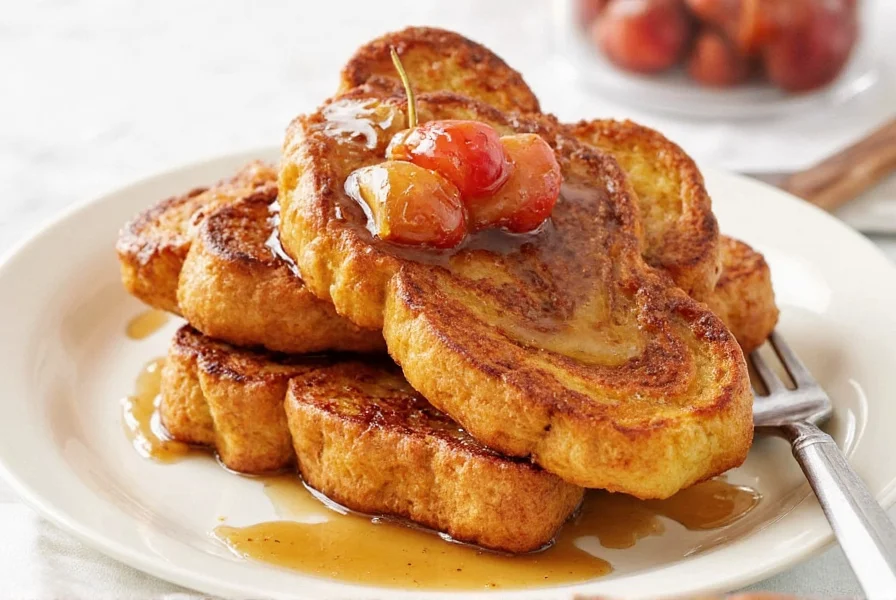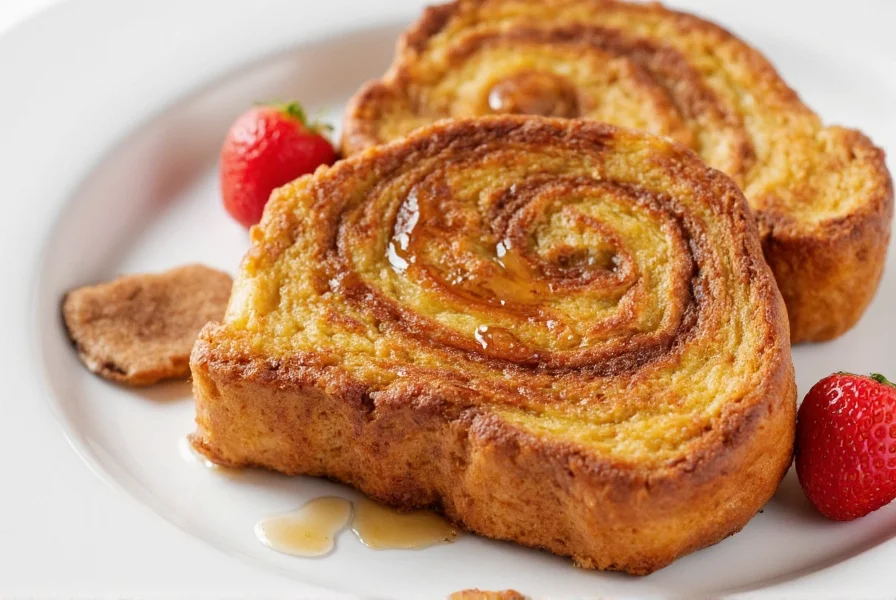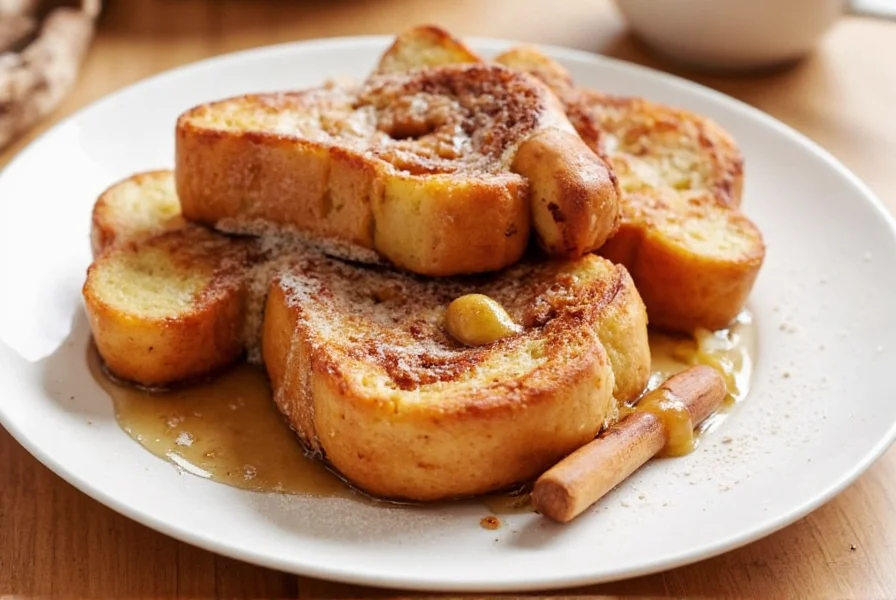If you've ever wondered how to make cinnamon swirl french toast that rivals your favorite brunch spot, you've come to the right place. This guide delivers professional techniques that transform ordinary French toast into an extraordinary breakfast experience with minimal effort. The secret lies in the swirl technique and proper bread selection—details most recipes overlook.
Why Cinnamon Swirl French Toast Stands Out
Traditional French toast gets its flavor from toppings added after cooking. Cinnamon swirl french toast, however, integrates the cinnamon directly into the preparation process. When you master the swirl technique for cinnamon french toast, you create beautiful marbling that distributes flavor evenly while preventing the cinnamon from burning during cooking—a common problem with surface-sprinkled versions.
The ideal cinnamon swirl ratio creates pockets of molten cinnamon that contrast perfectly with the rich custard interior. This technique works best with slightly stale bread, which absorbs the egg mixture without becoming soggy. Brioche remains the top choice for cinnamon swirl french toast due to its buttery richness and structural integrity, though challah makes an excellent dairy-free alternative.
Essential Ingredients for Perfect Cinnamon Swirl French Toast
Quality ingredients make the difference between good and exceptional cinnamon swirl french toast. Here's what you need:
| Ingredient | Why It Matters | Pro Tip |
|---|---|---|
| Day-old brioche | Absorbs custard without disintegrating | Cut 1" thick slices for optimal texture |
| Whole eggs | Creates rich custard base | Room temperature for smoother mixture |
| Heavy cream | Adds luxurious texture | Substitute half-and-half for lighter version |
| Dark brown sugar | Deep caramel notes enhance cinnamon | Pack firmly for consistent measurement |
| Ceylon cinnamon | Milder, more complex flavor than cassia | Grind whole sticks for fresher taste |

Step-by-Step Preparation Guide
Follow these precise steps for restaurant-quality cinnamon swirl french toast at home:
- Prepare the bread: Cut 1" thick slices from a slightly stale brioche loaf. Stale bread (24-48 hours old) absorbs custard better without becoming mushy.
- Create the cinnamon swirl mixture: Combine 1 cup dark brown sugar, 3 tablespoons Ceylon cinnamon, and 2 tablespoons melted butter. This ratio prevents bitterness while ensuring visible swirls.
- Make the custard base: Whisk 4 eggs, 1 cup heavy cream, 1/4 cup maple syrup, 1 teaspoon vanilla extract, and a pinch of salt until completely smooth.
- Swirl technique: Dip each bread slice briefly in custard, then use a butter knife to create a pocket in the center. Spoon 1-2 teaspoons of cinnamon mixture inside, then gently press to seal while creating visible swirl patterns.
- Cook properly: Heat clarified butter in a cast-iron skillet over medium-low heat (325°F). Cook 3-4 minutes per side until deep golden brown. Never rush this step—proper temperature prevents burnt cinnamon.
Critical Cooking Tips Most Recipes Miss
Achieving perfect cinnamon swirl french toast requires attention to details many recipes overlook:
- Bread moisture balance: If your bread is too fresh, toast slices at 300°F for 10 minutes before preparing. Too-dry bread won't hold the swirl pattern.
- Cinnamon distribution: Use the "pocket method" rather than surface sprinkling to prevent burnt cinnamon spots while ensuring flavor throughout.
- Temperature control: Maintain consistent 325°F heat—higher temperatures cause the sugar in the swirl to burn before the custard sets.
- Resting time: Let cooked slices rest 2 minutes before serving. This allows the custard to set properly and prevents collapse.

Common Mistakes and How to Avoid Them
Even experienced cooks make these errors when attempting cinnamon swirl french toast:
- Soggy texture: Caused by fresh bread or over-soaking. Solution: Use day-old bread and dip for only 15-20 seconds per side.
- Burnt cinnamon: Results from high heat or surface sprinkling. Solution: Incorporate cinnamon into a sugar-butter mixture and cook at proper temperature.
- No visible swirls: Happens when the pocket isn't properly sealed. Solution: Gently press edges after filling to contain the mixture.
- Uneven cooking: Occurs with inconsistent slice thickness. Solution: Use a serrated knife and cut perpendicular to the loaf.
Variations for Different Dietary Needs
Adapt this classic cinnamon swirl french toast recipe for various dietary requirements without sacrificing flavor:
- Dairy-free: Substitute heavy cream with full-fat coconut milk and use coconut oil instead of butter.
- Gluten-free: Use thick-cut gluten-free brioche (like Schär) and increase egg content by 15% for better binding.
- Lower sugar: Reduce brown sugar to 1/2 cup and add 1/4 teaspoon stevia to maintain sweetness without excess sugar.
- Vegan: Replace eggs with 1 cup silken tofu blended with 2 tablespoons cornstarch and use plant-based milk.
Serving and Storage Recommendations
Maximize your cinnamon swirl french toast experience with these professional tips:
- Immediate serving: Always serve within 5 minutes of cooking for optimal texture. The custard interior begins to firm as it cools.
- Perfect pairings: Complement the rich flavor with tart elements like fresh raspberries or a citrus compote to cut through the sweetness.
- Reheating: Never use a microwave. Instead, reheat in a 350°F oven for 5-7 minutes to restore crispness without drying out.
- Make-ahead: Prepare assembled but uncooked slices, freeze on a baking sheet, then transfer to freezer bags. Cook directly from frozen, adding 1-2 minutes per side.
Frequently Asked Questions
What's the best bread for cinnamon swirl french toast?
Brioche is the ideal choice for cinnamon swirl french toast due to its rich egg content and sturdy structure that holds the swirl pattern. Challah makes an excellent dairy-free alternative with similar structural properties. Avoid soft sandwich breads as they become too soggy and won't maintain the distinctive swirl pattern during cooking.
Why does my cinnamon swirl french toast burn?
Cinnamon burning typically occurs when cooking at too high a temperature or when cinnamon is sprinkled on the surface rather than incorporated into a swirl. The sugar in cinnamon caramelizes quickly above 350°F. For perfect cinnamon swirl french toast, maintain medium-low heat (325°F) and ensure the cinnamon is mixed with sugar and butter inside the bread rather than on the surface.
How far in advance can I prepare cinnamon swirl french toast?
You can assemble cinnamon swirl french toast up to 24 hours in advance. Place prepared slices in a single layer on a parchment-lined baking sheet, cover tightly, and refrigerate. When ready to cook, let them sit at room temperature for 15 minutes before cooking. For longer storage, freeze assembled slices on a baking sheet, then transfer to freezer bags for up to 2 months. Cook directly from frozen, adding 1-2 minutes per side.
Can I make cinnamon swirl french toast without eggs?
Yes, you can create egg-free cinnamon swirl french toast by substituting each egg with 1/4 cup silken tofu blended with 1 tablespoon cornstarch. For best results, increase the dairy component by 25% to maintain moisture. The texture will be slightly different but still delicious. Many professional chefs use this method for vegan cinnamon swirl french toast with excellent results when using brioche-style vegan bread.











 浙公网安备
33010002000092号
浙公网安备
33010002000092号 浙B2-20120091-4
浙B2-20120091-4